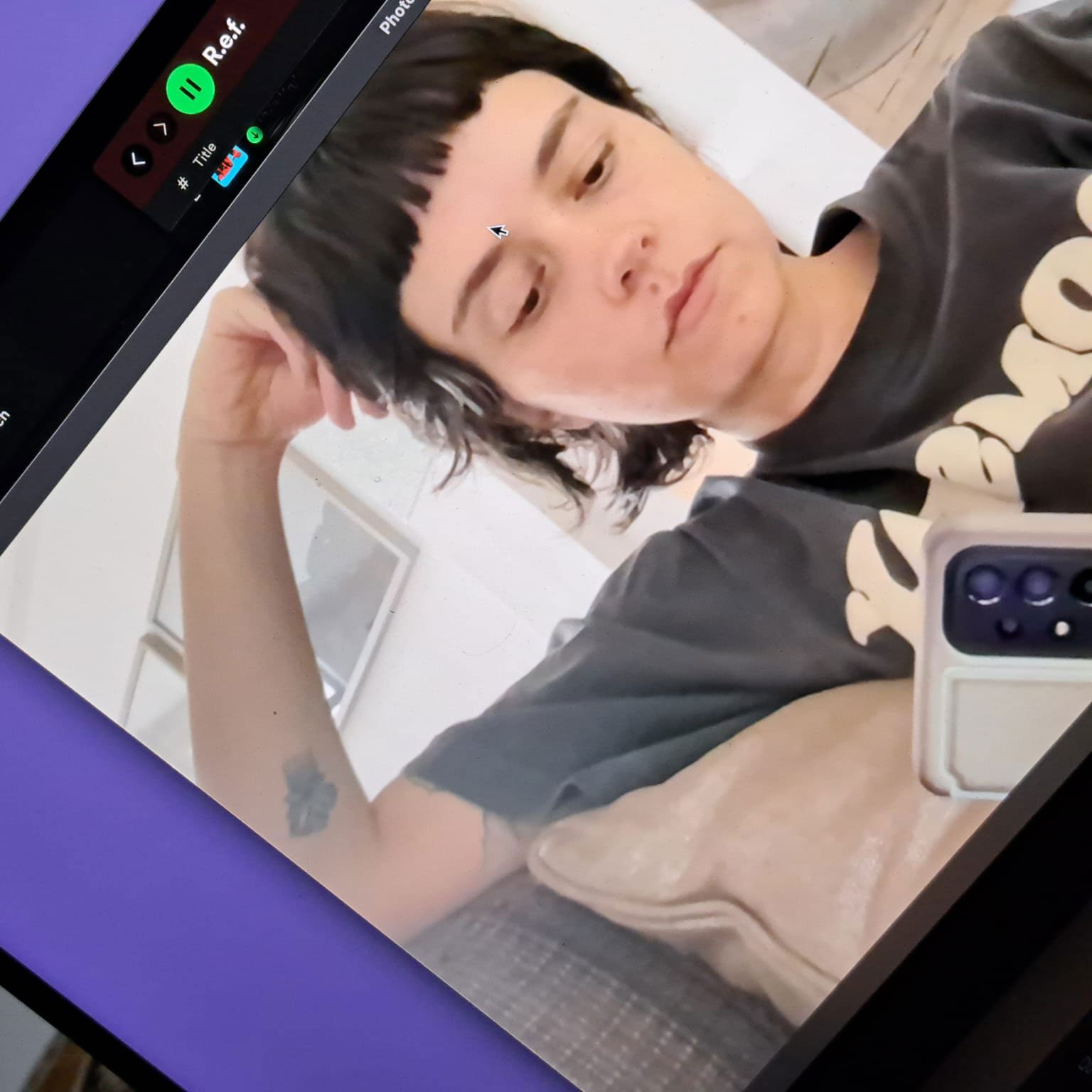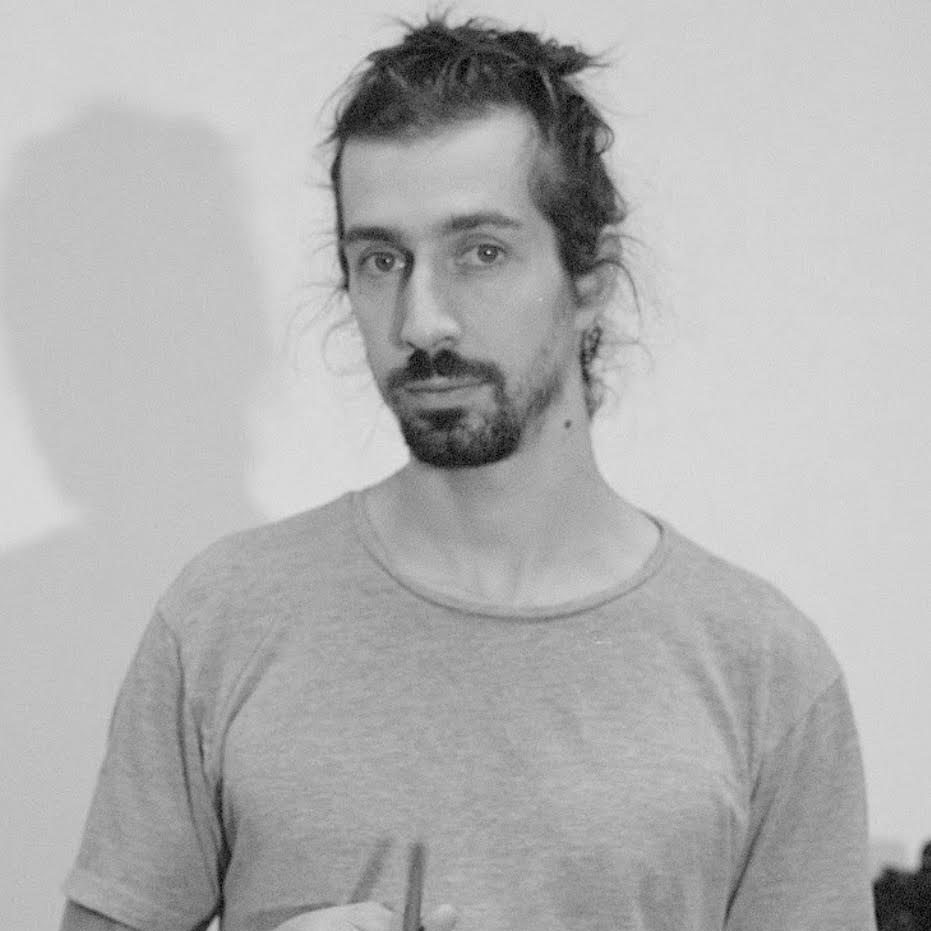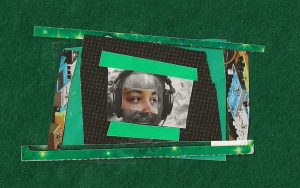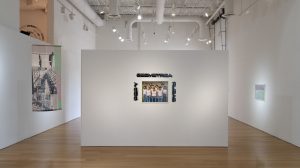“Quiero hacer una fiesta de reggaeton, con luces y mucho calor. Como un Gótico Tropical pero que sea una fiesta…una fiesta darks.” –Inés Arango-Guingue
During June of 2023, incipient Chicago summer, in a house that holds the memory of what once was a shelter for travelers of the city and now serves as an art space by the name Comfort Station, a lecture performance brought to life a Latin American vernacular. Inside this steamy small house in the middle of Logan Square that night, the heat, the reggaeton beats, and the humidity transported me to Colombian tiendas. In these small bodega-like bars, dance and celebration are central, while at the same time, an underlying tropical sadness is incarnated into the late hours. Dark and Hot was conceived by Inés Arango-Guingue, a performance that appealed to the sensual as a vehicle to break with the rational and get closer to that which cannot be explained. Inspired by the Colombian film movement Gótico Tropical (Tropical Gothic), and guised as a party, it played with the exoticization of festive tropicality, to ultimately invoke something dark and sorrowful.
The starting point was a two-hour Spotify playlist made up of songs that encapsulated the tension inherent in physically feeling dark and hot. Inside a room artificially warmed with heaters and with humidifiers running, the selection of music intended to induce a South and tropical party-like state. There were cheap party lights, heaters, and a few plants that created the atmosphere of an odd and eccentric party in this very small house. Seated at a desk and with a microphone in her hand, Arango-Guingue would interrupt the party to tell stories of witchcraft and horrors from the tropics that were organically related to the songs that were playing. The space was set up with two video projections with images, videos, and some of the lyrics of the songs, tying together the concept of darkness in the tropics.

Dark and Hot took on the legacy of Tropical Gothic, a film movement that defined darkness out of a specific origin: the heat in relation to the Colombian socio-political context. This film movement emerged in Cali, Colombia between the 1970s and the 1980s and its artists pondered what a horror film would look like in tierra caliente (“hot land”, a term used to refer to the warmer regions in Colombia). In cinema, the horror genre has been historically inspired by English Gothic literature from the 19th century, where narratives transported readers to cold and dark landscapes surrounded by ruins. These apparently supernatural characters belonged to these places: wolves inhabited cold forests; Nosferatu lived in a castle in Transilvania; and ghosts usually appeared in old dilapidated mansions. All these are examples of spaces that exist in correlation to their characters: spaces that are gloomy, dark, and cold.
So what is horror like in the tropics then, where the landscape is completely different? The darkness of European Gothic is transposed differently. In Colombia, darkness doesn’t come from zombies or vampires that inhabit cold landscapes, but from the realities in its territory. Tropical Gothic took the social, political, and cultural context to narrate stories that remained beyond rational understanding. Because horror is about the unknown, the macabre, what is hidden, and that which cannot be understood.
Cali, for instance, saw the rise of one of the largest drug cartels in the country; reinforced by mythologies that originated from slavery and colonization, narratives about the devil and dark forces became more prevalent, such as the story that recounts when the devil decides to go dancing at a nightclub and after being discovered decides to burn the body of a woman. Colombian culture has been shaped by the lived dynamics of extreme and omnipresent violence. Tropical Gothic filmmakers understood this, and almost as a way of syncretism, they reappropriated and displaced classic gothic characters into their context as a representation of one of the most violent periods in Colombia. For instance, in the film Pura Sangre (1982), Luis Ospina shows vampires as metaphors for the wealthy social class who sucked the blood of the poor and peasants: these were vampires who simultaneously inhabited tropical lands, danced to salsa, and consumed drugs.

People in Colombia grow up surrounded by a highly complex kind of darkness that stems from the effects that corruption, drug trafficking, civil war, and extreme poverty have had on society. This generated a specific representation of horror and darkness that resonates across tropical and Global South countries that share similar issues caused by colonialism, neoliberalism, and its consequent unequal social structures. People in these territories inhabit fear. A fear that eludes comprehension: we have heard about and lived through so many terrifying experiences that sound fictional but they are not. Fear and darkness are part of the essence of the tropics, but that feeling, when felt, is not fully understood, and I believe this is what Dark and Hot was about: the sensation that something is hidden; the sadness underlying a party; a feeling of strangeness accompanied by a sensation of warmth and humidity on the body and mind.
In Colombia we use the word caliente to describe a dangerous situation, while its literal meaning is hot, referring to the feeling of heat. In English and Spanish, the word hot can also be understood as sexy. Dark and Hot condensed all these terms. Playing songs like El muerto se fue de rumba by Hermanos Castro Orchestra, Para Ochún by Héctor Lavoe, and Pobre Diabla by Don Omar, an atmosphere of dance began to be created, but the lyrics of the songs spoke of everything but happiness. People danced to hot music about enchantments and spirits that go dancing in the night.
“En casa del difunto
No hacían más que llorar
Pero de pronto el muerto
De allí desapareció
Apenas sintió la conga
El muerto salió de rumba”
“In the house of the deceased
They did nothing but cry
But suddenly the dead person
Disappeared from there
As soon as he felt the conga
The dead person went out with the rumba”
(Orquesta Hermanos Castro, El muerto se fue de rumba. 1945)
Arango-Guingue invited the Chicago-based audiovisual artist fleming and me to participate in this performance by mixing sounds and projecting videos inspired by the stories contained in the songs, highlighting some of their lyrics. The music selection evoked an uncanny festive atmosphere that invited us to dance, but summoned, at the same time, the sinister darkness of the tropics. Dark and Hot gave the sensation (from the sensual) that something hid behind the party. There was reggaeton, cumbia, vallenato, salsa, and son cubano, all of them containing intense and energetic rhythms that described something wild and fiery. Something hot: something caliente.
“No juegues con el Diablo
No juegues con el Diablo
El diablo come candela
Y te puede agarrar
Y te puede comer
1,2,3 qué rico”
“Don’t play with the Devil
Don’t play with the Devil
The devil eats fire
And he can grab you
And he can eat you
1,2,3 how delicious”
(Company Quinto, El Diablo. 1968)
This was not just a party; it was a lecture performance, which was inspired by works such as Éricka Florez’s Hegelian Dancers – Burning Geometries (2019), a conferencia bailable (danceable lecture) which explored epistemologies of dance by demonstrating that tropical rhythms are capable of dismantling the power dynamics and binaries created by Western culture. Because the party in Dark and Hot was constantly interrupted by Arango-Guingue’s voice—as she told these uncanny tales—the performance created a state of low attention towards the stories which “should’ve” been understood (because it was a lecture), as these were displaced by the impulse of the body to feel the beat, humidity, and heat. The attempt to be transparent and make her voice understandable failed because we were all perreando y llorando, dancing and crying.

Most Western countries assume that Latin American people know how to party and dance. It’s a representation that comes from the idea of the tropics: a sunny, hot, and happy place. The danger of this perspective lies in denying our possibility for sadness, fear, and darkness, they are stereotypes that don’t allow us to cry, don’t allow us to be. Us, the performers in this piece were either of Latin American origin or queer. We were the others, the bodies that refused to be represented through a Western lens. And it’s in this that opacity becomes central to this project.
In Poétique de la Relation (1991) the poet and philosopher Édouard Glissant developed the concept of Opacity. In this specific case, Opacity can be understood as a positive force that opposes homogenization and understanding. Glissant focuses on the complexity of Caribbean cultures, and, from that perspective, he defines Opacity as that which can contain bodies by asserting their right to resist total transparency, understanding, or assimilation. According to Arango-Guingue, “Opacity can protect diversity by preserving the mystery of these identities, and with this, it challenges Western narratives that seek to flatten the other through rationality.”
A lecture is a format designed to explain, to teach, to present, and for the other to understand. It comes from the West. It’s meant to be transparent. Arango-Guingue narrated personal stories related to Loas (spirits), art, Voodoo, the devil in Cali, Tropical Gothic, and violence in relation to the songs that were playing. On the other hand, a performance is something that happens through the body, it is sensory and sensual and often tries to go beyond rationality. Dark and Hot was a lecture performance that stood on the edge between the dichotomies of a party with lights, smoke, heat, and humidity, and a voice that tried (or avoided) to narrate. Arango-Guingue and the performers sought a lack of clarity to resist the colonial impulses of the West.

Dark and Hot was presented in the United States, which gives it a particular weight and perspective. Showing the piece in a Northern country of a Western and hegemonic culture adds a migration layer to it. In this case, this work also questions the stance and space that a Latin body occupies and how it strives to resist.
While I was writing this text, I spoke to Arango-Guingue and she filled me in on Mictlán Productions, a collective that organizes Latinx techno parties, mostly in Chicago. They promote the parties as eventos para los darks, which makes me think that this idea of Tropical Gothic continues to appear and be relevant in contemporary spaces outside of art. Perhaps bodies that don’t belong still seek a place that gives them the space to reclaim their right for darkness, fear, and sadness. For instance, techno is not associated with a Latin party. It’s a type of music that has its origins in the United States, and currently, it serves as a representation of the party scene in Berlin. What happens with the representation of a Latin body inhabiting a white territory, dressed as a goth, dancing to techno, and claiming its right to not be festive and happy?
Dark and Hot arose from the urgency to do something with the fear, sadness, and darkness that are kept unseen. The party highlighted the paradox that emerges when we dance sadly, feeling in the skin the heaviness of what it implies to be a Latine or a queer body that inhabits intersectionalities that go beyond rational understanding: bodies that dance, sweat, are afraid, but also intend to avoid being narrated.
This performance was a Latin American vernacular that gave an intense feeling of something that was hidden behind the guise of a party. It opened the possibility to feel dark and caliente through a specific music selection, witchcraft storytelling, and through the physical sensation of heat and humidity. It touched on ideas hailing from Tropical Gothic–weaving them into a sort of danceable lecture party to rescue the sensual: what is felt.

About the Author: Juliana Castro Duperly, video and sound artist interested in language as a performative act. Video, sound, and words are plastic media capable of constructing and deconstructing meaning. This duality has forced her to think of her practice as a flexible and fluid place, where language can be perceived as an experience and not as an operational matter. Taking her work to places of vulnerability forces her to have an openness that tends to search for that moment that exists before articulation.
She has showed her work in Sónar Bogotá, Mutek.co, Festival Domo Lleno, VANSA, Elastic Arts, ESS, and Ars Electronica.

About the Photographer: Jonas Müller-Ahlheim (*1993 in Wiesbaden, Germany) is a German artist who studied at the Royal Academy of Fine Arts, Copenhagen and graduated in 2021 from The Art Academy Karlsruhe as a Meisterschüler with Professor Leni Hoffmann. From 2021 to 2023 he was awarded the DAAD – German Academic Exchange Service scholarship to continue his research at the Painting Department of the School of The Art Institute of Chicago (SAIC), from which he graduated with an MFA. He is currently a teaching Fellow at the School of the Art Institute of Chicago.



